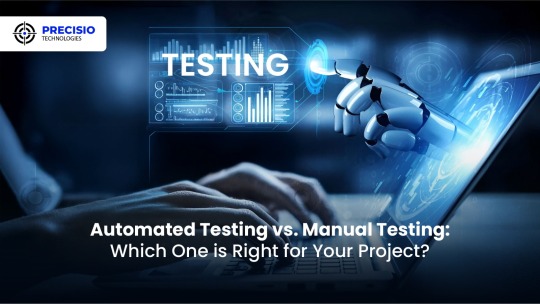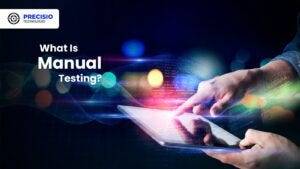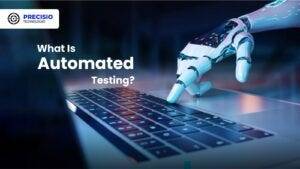#Manual Testing
Explore tagged Tumblr posts
Text
Automated Testing vs. Manual Testing: Which One is Right for Your Project?

Achieving high-quality, reliable software stands as a fundamental requirement in software development. Successful testing functions as an essential tool to discover faults and build performance capabilities that create better user experience outcomes. Two main testing methods dominate the field: automated testing and manual testing. The process of quality software assurance uses different testing approaches that demonstrate their own advantages as well as weaknesses according to specific project requirements and scenarios. We will explore the specifics to determine which testing process works best for your system development efforts.
1. What Is Manual Testing?

Manual testing involves a human tester manually executing test cases without using automation tools. Key Characteristics:
The methodology focuses its efforts on user interface together with usability and experience testing.
Human-centered applications where selection requires discretion include ad hoc testing and enumerative testing as well as examinations that need human evaluation.
Human performers are required during this approach; thus, it demands substantial time.
2. What Is Automated Testing?

Software performing automated testing executes test cases through workflows and helpers. Key Characteristics:
Efficient for repetitive and regression testing.
Users must spend money on tools along with developing custom scripts for testing.
Reduces human error.
3. Advantages of Manual Testing

Human Intuition: Software testing professionals can detect kernels through their human cognitive ability that automated tools cannot match. The observation and evaluation of visual elements runs more efficiently through human operatives instead of advanced tools.
Flexibility: This method suits exploratory testing specifically because there are no pre-determined scripts available.
Low Initial Investment: Running this approach does not need tool purchases or applications to develop automation frameworks.
Adaptable for UI/UX Testing: Running this approach does not need tool purchases or applications to develop automation frameworks.
4. Advantages of Automated Testing

Speed: Executes repetitive tests much faster than humans.
Scalability: The system proves most effective for extensive projects that need constant system updates.
Accuracy: When performing recurring actions, automated systems minimize the chances of human mistakes.
Cost-Efficient in the Long Run: Once established and implemented, the system demands costly investments but ensures continuous development expenses decrease over time.
Better for CI/CD Pipelines: Such testing technology connects various development pipelines that support agile and DevOps methodologies.
5. Disadvantages of Manual Testing

Time-Consuming: The manual performance of repeated tests leads to delayed completion of projects.
Error-Prone: Large applications contain tiny bugs that human testers commonly fail to detect.
Not Ideal for Scalability: The process of increasing manual testing needs additional testers to avoid cost escalations.
6. Disadvantages of Automated Testing

Initial Costs: Organizations must provide high financial resources to procure testing tools together with developing programming constructs.
Limited to Pre-Defined Scenarios: These testing approaches work poorly for handling exploratory or ad hoc testing.
Requires Maintenance: Test scripts need frequent updates when application changes occur.
Not Suitable for UI/UX Testing: Struggles with subjective user experience evaluations.
7. When to Use Manual Testing

Small Projects: The testing method proves beneficial at a low cost for small applications and provides quick assessments.
Exploratory Testing: Testing this approach benefits projects whose scripts have not been defined yet or need evaluation for newly added features.
Visual and Usability Testing: Performing assessments on interface components together with design features.
8. When to Use Automated Testing

Large Projects: Handles scalability for projects with frequent updates.
Regression Testing: Program testing becomes more efficient through automation since automated assessments perform multiple tests following each update process.
Performance Testing: The system performs efficient capabilities to conduct load testing and stress testing.
Continuous Development Environments: Agile progression and DevOps implementations need automation as a core requirement.
READ MORE- https://www.precisio.tech/automated-testing-vs-manual-testing-which-one-is-right-for-your-project/
2 notes
·
View notes
Text
#automation testing#manual vs automation#automation vs manual#manual testing#software testing services
2 notes
·
View notes
Text
QA & SOFTWARE TESTING - SPARK TECHNOLOGIES

As a world-class IT services provider with years of experience across various sectors globally. Spark Technologies delivers the business IT solutions you need to enhance efficiency, add value, and reduce costs. We design, develop, implement, manage, and optimize access to systems and information, addressing your business processing, application, and infrastructure needs.
click here for more
2 notes
·
View notes
Text
#QA Testing#Quality Assurance#Bug Detection#Automated Testing#Manual Testing#Performance Testing#Websar IT Solutions
0 notes
Text
10 of the Top Software Testing Companies in 2025
In the rapidly evolving tech world, delivering flawless digital experiences is no longer optional—it's essential. Software testing companies play a crucial role in ensuring applications are functional, secure, and user-friendly. Here’s a look at 10 of the top software testing companies in 2025, recognized globally for their innovation, reliability, and comprehensive QA services.
1. QualityLogic
Headquartered in the U.S., QualityLogic is known for its high-quality software testing and test automation services. They specialize in web and mobile app testing, API testing, accessibility (ADA/WCAG), and smart energy testing. With decades of experience and a focus on agile development, QualityLogic offers a powerful mix of manual and automated QA services.
2. Mindful QA
Mindful QA is a U.S.-based company offering flexible manual and automated testing services. They focus on ethical practices and transparency, making them a trusted partner for startups and large enterprises alike. Their specialties include mobile app testing, performance testing, and API testing.
3. Cigniti Technologies
Cigniti is a global leader in digital assurance and software testing services. With a wide range of offerings including AI/ML testing, performance, security, and automation testing, Cigniti serves industries such as healthcare, finance, and e-commerce. Their enterprise-grade solutions and global presence make them a top-tier choice.
4. A1QA
With offices in the U.S., UK, and Europe, A1QA offers full-cycle software testing services including functional, performance, security, and usability testing. Their client-focused approach and advanced testing infrastructure have earned them a strong reputation in the QA industry.
5. QASource
QASource combines offshore affordability with U.S.-based management to deliver high-quality testing services. They offer automation testing, mobile QA, DevOps testing, and more. Their domain expertise across industries like healthcare and finance sets them apart.
6. iBeta Quality Assurance
iBeta, based in Colorado, is known for its robust functional, performance, and biometric testing capabilities. They serve industries ranging from healthcare to gaming and are ISO-certified, making them a great choice for compliance-driven testing projects.
7. Global App Testing
Global App Testing specializes in crowdtesting, enabling real-time functional and localization testing through a global network of testers. They help companies launch better digital products faster, with QA coverage in over 190 countries.
8. TestingXperts
A part of the DAMCO Group, TestingXperts offers next-gen QA services including AI testing, IoT testing, and cloud application testing. Their scalable solutions and global delivery model help enterprises ensure faster and more reliable software releases.
9. ScienceSoft
With 30+ years in IT, ScienceSoft has evolved into a comprehensive QA partner offering manual and automated testing, cybersecurity, performance testing, and test consulting. Their deep technical expertise supports both startups and enterprises worldwide.
10. Moolya Testing
Based in India, Moolya is known for its exploratory testing, agile QA practices, and deep domain knowledge. Their team focuses on delivering bug-free, user-centric software through innovative testing methodologies.
Conclusion:Choosing the right software testing company depends on your project’s complexity, domain, budget, and timelines. These ten companies stand out for their proven track records, cutting-edge tools, and customer satisfaction. Whether you're a startup launching your first app or an enterprise scaling your QA process, these firms offer the expertise to help you deliver high-quality software in 2025 and beyond.
0 notes
Text

Master Playwright Test Automation with Live Online Training
Playwright Test Automation in TypeScript/JavaScript. Join expert-led live online training to boost your QA career opportunities.
#QA / Testing Tools#Python Training#Selenium Training#Playwright#Web Services Testing#Manual testing
0 notes
Text
0 notes
Text
Boost Your Application Performance with JMeter – Powered by QO-BOX In software testing, performance is key to providing a seamless user experience. Apache JMeter is an open-source tool that helps in load testing, performance testing, and analyzing how applications perform under heavy traffic. It supports multiple protocols like Web, APIs, and Databases, making it a versatile solution for scalability, stability, and reliability testing. At QO-BOX, we leverage tools like JMeter to ensure your application is robust and ready for real-world demands. Our expert team provides customized test plans, real-time reporting, and CI/CD integration for enhanced performance. https://qo-box.com/
#jmeter#automation#manual testing#quality engineering#erp software#security testing#innovation#quality assurance#software
0 notes
Text
Why GKV Software Solutions Is (Actually) the Best Software Testing Service Provider

Let’s be honest. When you think of software testing services, the words “exciting,” “creative,” or “human” don’t immediately jump to mind. Most of us imagine bug reports, test cases, maybe a very tired QA team hunched over a keyboard, sipping cold coffee.
But what if we told you that somewhere between all the crash logs and Selenium scripts, there’s a company quietly making software safer, smarter, and smoother?
Meet GKV Software Solutions—a team that’s not just ticking boxes but redefining what great QA looks like. If you’ve ever wondered what separates “just okay” testing from “wow, everything just works,” this is your answer.
We Don’t Just Test Software—We Torture It (Lovingly)
GKV doesn’t believe in the “click it once and move on” philosophy. Nope.
We poke, prod, stress, and straight-up roast your software (in a good way). From functional testing that checks every button, to performance testing that asks, “What if 10,000 people tried this at once?”—We push your app to its limits so your users don’t have to.
Basically, we break it so your customers can’t.
And with QA testing services this rigorous, glitches, crashes, and embarrassing bug reports become relics of your past.
Tools? Oh, We Have Tools. Fancy Ones.
If you thought automated software testing just meant hitting “record” and walking away, GKV would like a word.
We use frameworks like Selenium, TestComplete, and other futuristic-sounding things that make testing faster, more accurate, and far less painful. The goal? Let machines do the grunt work while our human testers focus on the big picture.
So yes, robots are involved. But it’s still all heart under the hood.
our QA Team? Not Just Qualified—Certified Sorcerers
Okay, maybe not actual sorcerers. But the GKV QA team does have a magical ability to sniff out issues most devs wouldn’t even dream of.
We’ve tested software for industries ranging from healthcare to e-commerce, fintech to logistics, and we know what it means to get things right the first time.
We understand regulatory hoops. We speak fluent “developer.” And we know how to translate “this isn’t working” into “here’s exactly how to fix it.”
Client-Centric Isn’t Just a Buzzword
Lots of companies say We’re client-focused. GKV actually shows it.
Before diving into a single test case, we get to know your goals, your tech stack, your pain points, and (yes) your deadlines. We tailor our entire QA strategy to your needs, whether you’re launching a mobile app or scaling a complex enterprise platform.
With GKV, you’re not just hiring a software testing company—you’re getting a partner who’s invested in your success.
Continuous Improvement Is in Our DNA
Technology evolves fast. QA practices? Even faster. What worked six months ago might be laughably outdated today.
GKV doesn’t just keep up—We stay ahead. Our team actively tracks trends in QA automation, DevOps integration, shift-left testing, and all the fancy stuff we pretend to understand.
Translation: We’re always getting better, so you don’t have to worry about falling behind.
People Are Talking (And the Talk Is Good)
You know what’s better than us telling you GKV is amazing?
Real clients saying things like:
“We used to get bug reports weekly. Since switching to GKV, our QA cycles are clean, fast, and drama-free.”
Or:
“We didn’t just test our app—We understood it. That’s rare.”
When you’re shopping for the best software testing service provider, that kind of word-of-mouth is priceless. And yeah, GKV earns it.
One Size Doesn’t Fit All—and We Know That
Different industries have different demands. GKV’s been around long enough to know that what works for a banking app definitely doesn’t work for a mobile game.
So whether you’re in healthcare needing HIPAA-compliant systems tested, or launching an e-commerce site just in time for Black Friday, we’ve got QA strategies built for your world.
This is tailored testing, not templated nonsense.
We Take Security Seriously (Because You Should Too)
In a time where apps leak passwords faster than you can say “data breach,” security isn’t optional—it’s non-negotiable.
GKV’s got a whole playbook for security testing. We’ll find holes in your defenses, plug them fast, and make sure your product complies with global standards like GDPR and HIPAA.
Your users won’t know how secure your software is. But we will notice that nothing ever goes wrong. And that’s the point.
No Strings, Just Smart Models
Need a dedicated QA team? Great. Want a one-time automated testing sweep before launch? No problem.
GKV offers flexible engagement models that match your project’s size, timeline, and budget. You only pay for what you need, and you always know exactly what you’re getting.
No hidden costs. No vendor lock-in. Just quality testing when and how you want it.
So… Why Is GKV the Best Software Testing Service Provider?
Because we do the hard stuff better than anyone else, we’ve mastered the science of quality and wrapped it in a human-first approach. Our team genuinely cares, our methods are solid, and our results speak for themselves.
And in a world full of broken features, late bug reports, and “Oops, we missed that,” GKV’s QA team is the calm, capable force keeping your product flawless.
TL;DR — Here’s What You Get with GKV:
Bulletproof software testing services
A team that speaks tech and human
Access to cutting-edge tools for automated software testing
Tailored QA for your industry
Real support, real flexibility, real results
Whether you’re a startup gearing up for launch or an enterprise keeping millions of users happy, GKV Software Solutions is the QA partner you wish you’d hired sooner.
So go ahead. Break things. We’ve got your back.
Ready to ditch flaky bugs and flaky testers?
Visit gkvsoft.com and discover why more companies choose GKV as their go-to QA testing partner.
#manual testing#software testing#qa services#gkv software solution#software testing service provider#Best Software Testing Service Provider
0 notes
Text
What are the steps involved in automated functional testing?
Functional Testing Services

Automated functional testing helps ensure that every feature of a software application works exactly as expected. Unlike manual testing, which relies on testers to check each function step by step, automation uses tools and scripts to speed up the process and improve accuracy. Here's a simple breakdown of the main steps involved in automated functional testing.
1. Requirement Analysis:
The first step, or the starting stage, is to know and understand precisely what the application and product should do. Testers review business and functional requirements to identify which features must be tested. This step ensures that the tests cover all critical functions of the application.
2. Test Planning and Tool Selection:
Once the requirements and demands are matched and understood, the next step is to create a well planned testing strategy. While this process consists of selecting the right set of tools and resources for automation (like Selenium, TestComplete, or UFT), defining the major test objectives, identifying the common test data, and deciding which tests are meant to automate based on the features' complexity, frequency, stability.
3. Test Case Design:
Testers and professionals seek to write up the automated test scripts based on the application's functionality in this phase as a common practice. Each script simulates a user action that verifies that the particular feature works correctly and goes well as said. Well-designed scripts ensure that key business processes are tested thoroughly.
4. Environment Setup:
Moving ahead towards the further tests process, it's essential to craft the test setting premises. As it consists of configuring servers, databases networks, and required alignments for better approach and perfection. As the stable setting assures accurate test results will be settled out and procured as per the given concerns.
5. Test Execution & Completition:
While the automated scripts are executed all across the different devices, platforms, or browsers as needed and approached. Tools run the tests, capture results, and log failures or issues. This step is much faster than manual testing and allows repeated testing without extra effort.
6. Result Analysis and Reporting:
After the tests run, the results are reviewed. Any failed tests are analyzed to identify the root cause. Detailed and complete set reports are generated and shared within the knowledge of the development team for fixing the issues quickly and with less time consideration.
7. Maintenance:
As the application evolves, automated scripts need to be updated. Maintenance assures the functional testing suite stays relevant and appropriate and tends to delivers accurate results over time. Companies like Suma Soft, IBM, Cyntexa, and Cignex are experienced in offering reliable automated functional testing services. Their expertise helps businesses maintain software quality while speeding up delivery and reducing testing efforts.
#software testing#it services#technology#software#saas#saas development company#functional testing#manual testing
1 note
·
View note
Text

In today's technology-driven world, software quality assurance plays a vital role in ensuring the delivery of reliable and user-friendly applications. While automated testing has gained popularity for its efficiency and speed, the art of manual testing remains an indispensable component of comprehensive testing strategies. This blog post aims to shed light on the power of human expertise in software quality assurance through manual testing. We will explore the benefits, best practices, and the importance of manual testing training in today's dynamic software development landscape.
1: Understanding Manual Testing:
Manual testing involves the systematic and hands-on verification of software applications by human testers. It encompasses a wide range of activities, including test case design, test execution, bug reporting, exploratory testing, usability testing, and more. We will delve into the intricacies of manual testing and highlight its unique advantages over automated testing approaches.
2: The Role of Human Expertise in Manual Testing:
While automated testing tools offer efficiency and repeatability, human testers bring a level of intuition, creativity, and adaptability to the testing process. We will explore how human expertise enables testers to think critically, identify edge cases, and simulate real-life user interactions. Manual testing allows for exploratory approaches, uncovering hidden defects and enhancing the overall quality of the software.
3: The Benefits of Manual Testing:
Manual testing offers several significant benefits that cannot be easily achieved through automation alone. We will discuss how manual testing provides a more comprehensive view of the application, facilitates usability testing, and helps in evaluating user experience. It enables testers to identify cosmetic issues, perform ad-hoc testing, and ensure the application's compatibility across different platforms, devices, and browsers.
4: Best Practices for Effective Manual Testing:
Successful manual testing relies on adhering to best practices and following structured approaches. We will explore techniques such as test case design, test execution, defect reporting, and test documentation. Additionally, we will discuss strategies for maintaining test environments, ensuring proper communication between testers and developers, and fostering collaboration within the QA team.
5: The Importance of Manual Testing Training:
To unlock the full potential of manual testing, comprehensive training programs are essential. We will emphasize the importance of manual testing training and highlight the key areas that should be covered. From foundational testing concepts to advanced techniques, a well-designed training program equips testers with the necessary skills and knowledge to excel in their manual testing efforts.
6: Achieving a Balanced Testing Approach:
While manual testing holds its own importance, it is crucial to strike a balance between manual and automated testing approaches. We will discuss how organizations can establish an effective testing strategy that combines the strengths of both approaches, leveraging automation for repetitive tasks while harnessing the power of manual testing for critical thinking, exploratory testing, and user-centric evaluations.
Conclusion
In the realm of software quality assurance, manual testing remains an indispensable practice that unveils the power of human expertise. Its ability to simulate real-world scenarios, adapt to complex situations, and identify subtle defects makes it an invaluable component of comprehensive testing strategies. By investing in manual testing training and embracing the art of manual testing, organizations can elevate the quality of their software, enhance user experience, and gain a competitive edge in today's evolving digital landscape.
#software testing training#automation testing training in ahmedabad#selenium training in ahmedabad#manual testing#unicodetechnologies
0 notes
Text
Why should I choose Testexplore?
TestExplore offers comprehensive testing services designed to ensure the quality, performance, and reliability of your software. From functional and automation testing to performance and security assessments, TestExplore delivers tailored solutions to help businesses launch bug-free, high-performing applications.
0 notes
Text
Effective Testing Strategies are critical to software development. Regardless of the most rigorous software testing services in usa, the software released will still contain defects. Test engineers try their level best to detect these flaws before release time, but somehow or the other, these issues find their way through and reappear, regardless of how efficient the manual software testing process is. Test automation software is the most suitable method for enhancing the effectiveness, efficiency, and scope of your software tests.
0 notes
Text
Automated & Manual Testing: Understanding the Key Differences and Best Practices
Introduction

Software testing plays a critical role in the software development lifecycle, ensuring that applications function correctly, efficiently, and securely before they reach end users. Two primary approaches to testing are automated testing and manual testing. Both methods have their strengths and weaknesses, and understanding the differences between them is essential for delivering high-quality software.
This blog post explores the key aspects of automated and manual testing, including their advantages, disadvantages, when to use each approach, best practices, and how they complement each other in modern software development.
What is Automated Testing?

Automated testing uses scripts and tools to execute test cases without human intervention. It is primarily used for regression testing, load testing, performance testing, and repetitive tasks that require high accuracy.
Key Features
Uses tools like Selenium, JUnit, TestNG, and Cypress.
Requires test scripts written in Python, Java, or JavaScript.
Ensures fast execution and high accuracy.
Reduces human errors and integrates with CI/CD pipelines.
Advantages
Speed and Efficiency: Faster than manual testing, saving time.
Repeatability: Consistent test execution.
Scalability: Ideal for large applications.
Cost-Effective in the Long Run: Reduces manual labor.
Supports Continuous Testing: Fits DevOps workflows.
Disadvantages
High Initial Investment: Requires setup and maintenance.
Limited Scope: Not ideal for UI/UX validation.
Complex Maintenance: Scripts need updates.
Lack of Human Insight: Cannot detect aesthetic issues.
What is Manual Testing?

Manual testing involves human testers executing test cases to validate functionality, usability, and performance.
Key Features
Performed without automation tools.
Involves exploratory, usability, and ad-hoc testing.
Effective for UI/UX validation.
Essential for verifying complex use cases.
Advantages
More Flexibility: Quickly adapts to changes.
Lower Initial Cost: No need for automation tools.
Effective for UI/UX Testing: Evaluates user experience.
Better Error Detection: Identifies usability and accessibility issues.
Required for Exploratory Testing: Finds defects beyond predefined cases.
Disadvantages
Time-Consuming: Slower than automated testing.
Prone to Human Errors: Inconsistencies may arise.
Limited Scalability: Not suited for large applications.
Difficult to Maintain Consistency: Tester skills affect results.
By clicking here Get Started with a Free Trial
When to Use Automated Testing?

Regression Testing: Ensures new changes don’t break functionality.
Load and Performance Testing: Assesses system behavior under different conditions.
Repeated Test Cases: Runs the same cases multiple times.
Continuous Integration (CI/CD): Supports DevOps workflows.
When to Use Manual Testing?

Exploratory Testing: Identifies unexpected defects.
Usability Testing: Evaluates user interaction.
Ad-hoc Testing: Quick issue identification.
Small Projects: When automation is unnecessary.
User Experience Validation: Ensures usability and design quality.
Best Practices for Automated Testing
Select the Right Tools: Match tools to project needs.
Prioritize Test Cases: Automate high-impact tests.
Maintain Test Scripts: Regularly update scripts.
Integrate with CI/CD: Automate tests for faster releases.
Use Data-Driven Testing: Enhance test coverage.
Best Practices for Manual Testing
Define Clear Test Cases: Document steps and expected results.
Use Exploratory Testing: Go beyond predefined cases.
Leverage Test Management Tools: Track progress with TestRail or Jira.
Perform Regular Reviews: Collaborate with developers.
Focus on User Experience: Evaluate from an end-user perspective.
0 notes
Text
The Growing Impact of Specialized Software Testing Services in the Digital Era
In today's fast-paced digital world, ensuring flawless software performance is no longer optional—it's essential. Businesses across industries increasingly rely on expert software testing services to deliver seamless digital experiences. From augmented reality testing to QA outsourcing, the demand for specialized testing solutions is rising. Let's explore how different testing services contribute to quality assurance and why they matter in modern software development.
Augmented Reality Testing: Shaping the Future of UX
With the rise of AR in gaming, retail, and real estate, augmented reality test strategies are crucial. These tests validate 3D interactions, environmental responsiveness, and cross-device compatibility. Companies investing in AR need experienced independent software testing companies to ensure their immersive experiences work smoothly across various platforms and conditions.
HOC Testers and Web Services Automation
HOC testers (Higher-Order Component testers) are particularly relevant in React-based applications. They test complex UI logic and component reusability. Simultaneously, web services automation testing plays a vital role in ensuring seamless communication between APIs. Automated tools like Postman, SoapUI, or Rest Assured help validate endpoints, response times, and data accuracy, ensuring backend functionality aligns with frontend performance.
Offshore Software Testing and QA Outsourcing
For companies aiming to scale efficiently, offshore software testing and QA outsourcing are highly effective strategies. These services allow access to global talent and round-the-clock testing cycles. Top quality assurance outsourcing companies provide dedicated QA teams at competitive pricing, helping businesses speed up release cycles without compromising quality.
E-commerce Software Testing: Powering Digital Retail
In the e-commerce sector, user experience and transaction reliability are paramount. Ecommerce software testing ensures that shopping carts, payment gateways, and product filters function as expected. With cyber threats on the rise, thorough security and performance testing are also essential to protect customer data and maintain trust.
Performance Testing for Cloud Applications
As businesses migrate to the cloud, performance testing cloud applications becomes a key focus. These tests simulate real-world traffic to assess an app’s responsiveness, scalability, and stability. Tools like JMeter, LoadRunner, and BlazeMeter help identify bottlenecks, ensuring applications perform well under load.
Mobile App Testing Companies: Enhancing On-the-Go Experiences
A leading mobile app testing company ensures that your application runs seamlessly across various devices, screen sizes, and operating systems. Testing includes functionality, usability, compatibility, and security—helping brands deliver flawless mobile experiences. With millions of apps competing for user attention, high-quality mobile QA is a non-negotiable.
Why Choose an Independent Software Testing Company?
Partnering with an independent software testing company brings an objective perspective to the QA process. These firms specialize solely in testing, ensuring unbiased assessments, faster bug detection, and comprehensive test coverage. They often offer tailored solutions, from manual testing to full-cycle automation.
Conclusion
From advanced technologies like AR to high-stakes sectors like e-commerce, effective QA strategies are critical. Whether you're looking for software testing companies in the USA or seeking QA outsourcing solutions, aligning with a skilled testing partner ensures your digital product is fast, secure, and reliable. In a world where user experience defines brand loyalty, investing in expert software testing is not just wise—it's essential.
0 notes